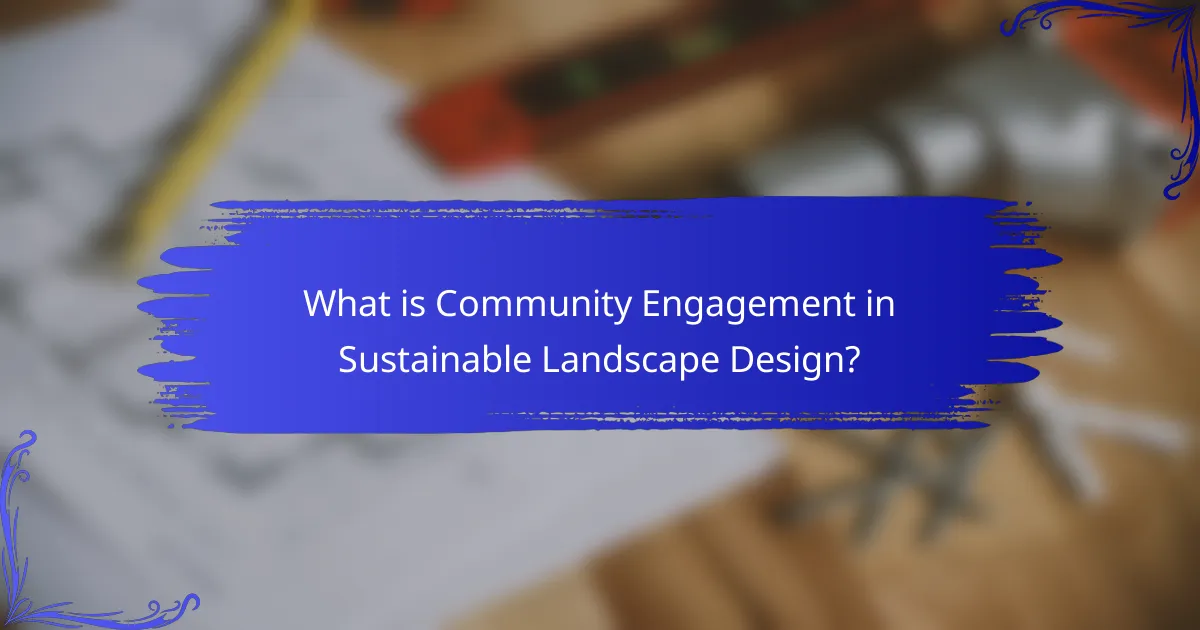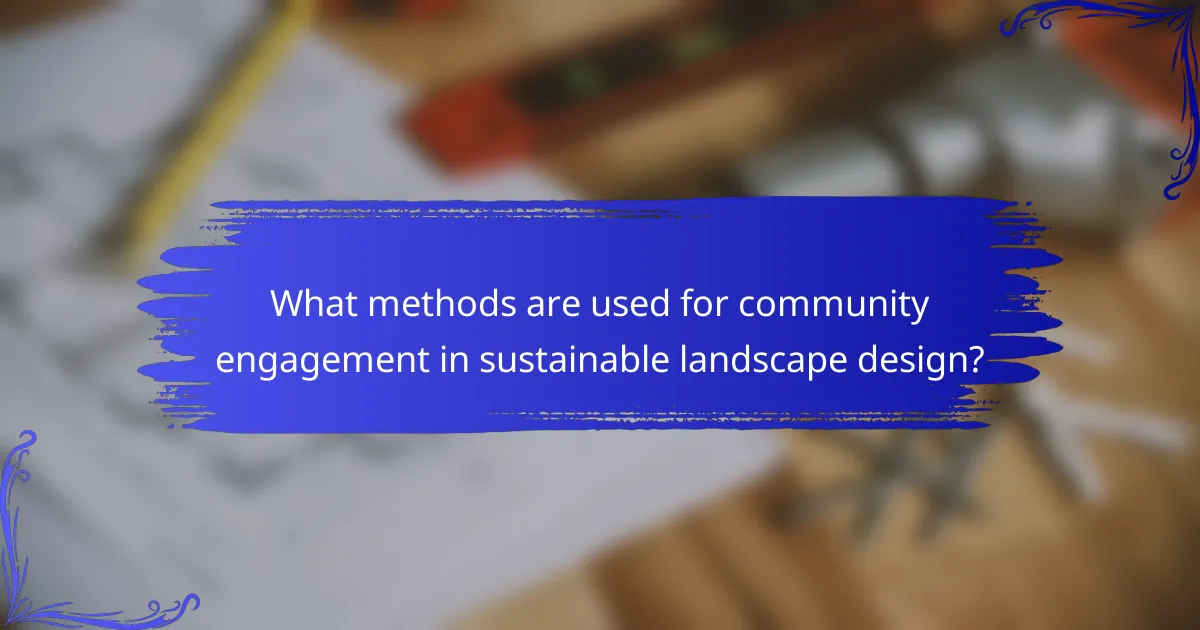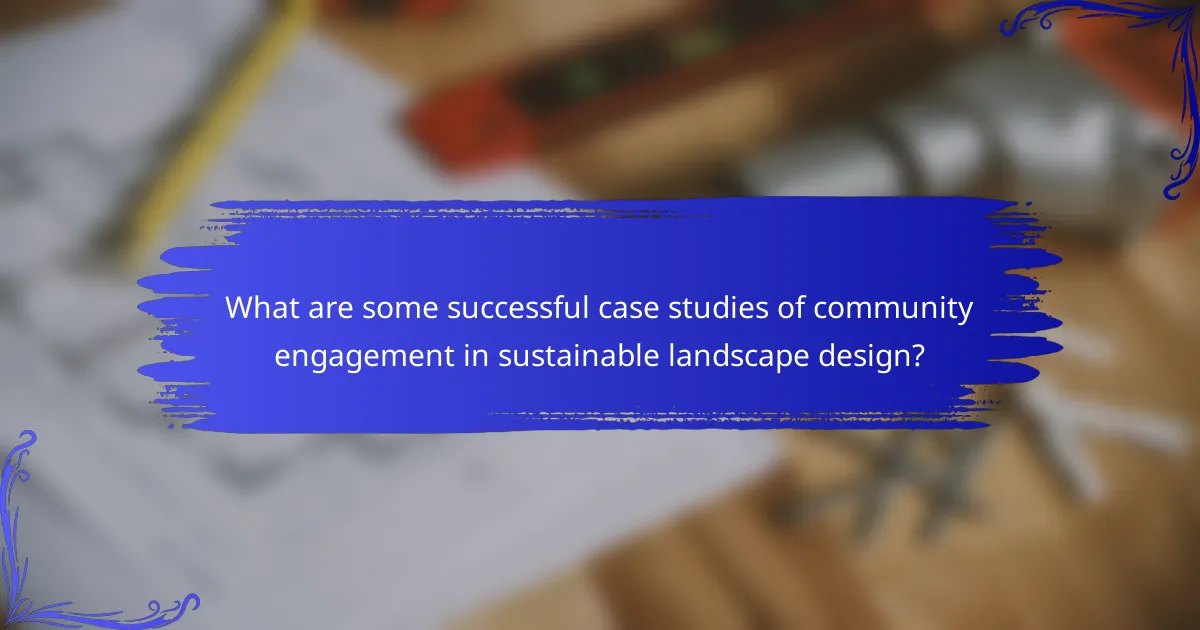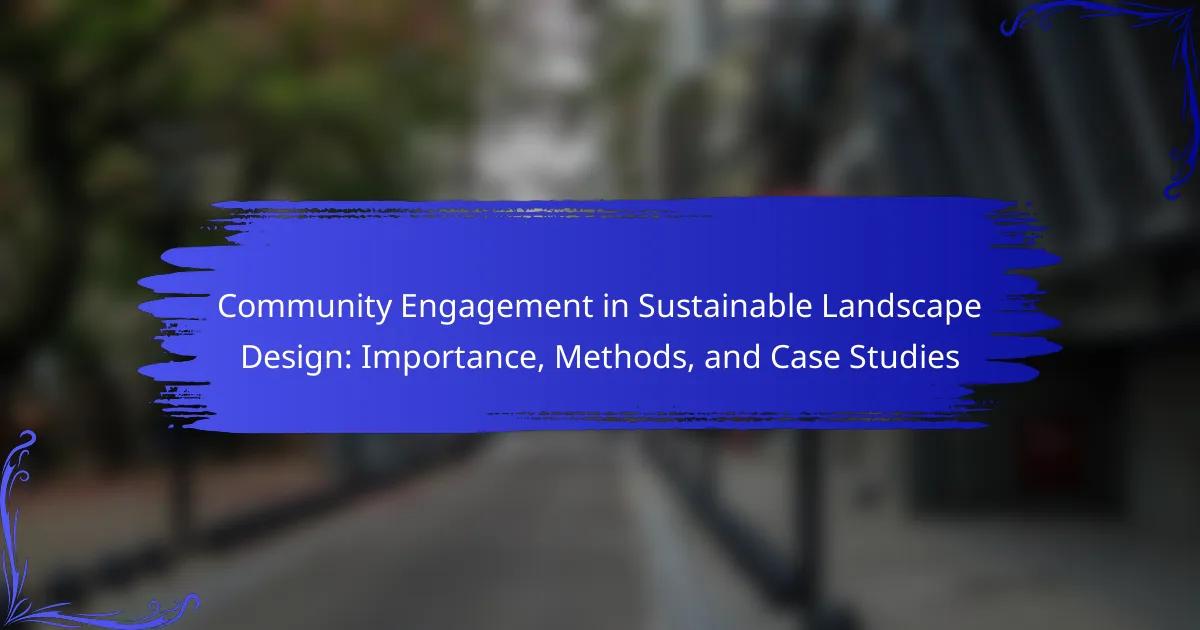Community engagement in sustainable landscape design involves the active participation of local communities in the planning and implementation of landscape projects. This engagement process is essential for ensuring that community needs and preferences are integrated, leading to improved ecological, social, and economic outcomes. Methods such as workshops, surveys, and participatory design sessions facilitate collaboration and gather valuable input from community members. Successful case studies, including the High Line in New York City and the San Francisco Green Streets Initiative, illustrate the effectiveness of community involvement in creating sustainable and relevant landscape designs. These examples highlight how community engagement not only enhances project success but also fosters a sense of ownership and stewardship among residents.

What is Community Engagement in Sustainable Landscape Design?
Community engagement in sustainable landscape design refers to the active involvement of local communities in the planning and implementation of landscape projects. This process ensures that the needs and preferences of the community are considered, fostering a sense of ownership and stewardship. Engaging the community can enhance the ecological, social, and economic outcomes of landscape designs. Studies show that projects with community input are more likely to succeed and be maintained over time. For example, research by the American Society of Landscape Architects highlights that community participation can improve project relevance and sustainability.
Why is community engagement essential in sustainable landscape design?
Community engagement is essential in sustainable landscape design because it ensures that the needs and values of local stakeholders are incorporated. Engaging the community fosters a sense of ownership and responsibility towards the landscape. This involvement leads to designs that are more relevant and beneficial to the users. Research indicates that projects with community input have higher success rates in sustainability. For instance, a study by the University of Minnesota found that community-involved designs resulted in 30% more satisfaction among residents. Additionally, community engagement can enhance biodiversity and ecological health by integrating local knowledge and practices. Thus, involving the community is crucial for creating effective and sustainable landscapes.
What are the key benefits of involving the community in landscape design?
Involving the community in landscape design enhances project relevance and effectiveness. It ensures that the designs reflect the needs and preferences of local residents. This involvement fosters a sense of ownership among community members. Studies show that community engagement leads to higher satisfaction with the final outcomes. It can also improve the sustainability of the project by integrating local knowledge. Engaged communities are more likely to support and maintain the designed spaces. Additionally, collaboration can lead to innovative ideas that professionals may overlook. Overall, community involvement creates landscapes that are more functional and meaningful.
How does community engagement contribute to sustainability?
Community engagement enhances sustainability by fostering collaboration and shared responsibility among stakeholders. Engaged communities are more likely to support sustainable practices and initiatives. They contribute local knowledge, which can inform better decision-making. For example, community input can lead to more effective environmental policies. Studies show that participatory approaches increase project success rates by up to 30%. Engaged citizens often advocate for sustainable resource use and conservation efforts. This collective action can reduce waste and promote recycling initiatives. Ultimately, community engagement creates a sense of ownership, driving long-term commitment to sustainability goals.
What are the core principles of community engagement in this context?
The core principles of community engagement in sustainable landscape design include inclusivity, transparency, collaboration, and empowerment. Inclusivity ensures that diverse community voices are heard and represented in the decision-making process. Transparency involves sharing information openly with community members, fostering trust and understanding. Collaboration emphasizes working together with stakeholders, including local residents, to achieve common goals. Empowerment focuses on equipping community members with the knowledge and skills needed to actively participate in the design process. These principles are essential for creating sustainable landscapes that reflect the needs and values of the community.
How can inclusivity be achieved in landscape design projects?
Inclusivity in landscape design projects can be achieved through community engagement and participatory design processes. Engaging diverse community members ensures that varying needs and preferences are considered. This can involve workshops, surveys, and focus groups to gather input from different demographics.
Incorporating universal design principles also enhances accessibility. Features like wheelchair ramps, tactile surfaces, and clear signage benefit all users. Additionally, designing spaces that cater to various cultural practices fosters inclusivity. For example, incorporating community gardens can serve as a gathering place for diverse groups.
Research shows that inclusive design leads to higher community satisfaction and usage rates. A study by the American Society of Landscape Architects found that community-involved projects see increased investment and maintenance. Thus, prioritizing inclusivity in landscape design not only meets diverse needs but also strengthens community ties.
What role does transparency play in community engagement?
Transparency fosters trust in community engagement. It ensures that stakeholders have access to relevant information. This access allows community members to understand decision-making processes. It encourages active participation and collaboration. Moreover, transparency holds organizations accountable for their actions. Research indicates that transparent practices increase community satisfaction. A study by the International Association for Public Participation found that transparency enhances public trust. Therefore, transparency is essential for effective community engagement.

What methods are used for community engagement in sustainable landscape design?
Methods used for community engagement in sustainable landscape design include workshops, surveys, and participatory design sessions. Workshops facilitate direct interaction between designers and community members. Surveys gather feedback on community preferences and needs. Participatory design sessions allow community members to contribute ideas and solutions. These methods foster collaboration and ensure designs reflect community values. Research shows that engaging communities leads to more successful and sustainable outcomes in landscape projects.
How can surveys and questionnaires facilitate community input?
Surveys and questionnaires facilitate community input by systematically gathering opinions and preferences from residents. They provide a structured way to collect data on community needs and priorities. This method allows for quantitative analysis of responses, making it easier to identify trends. Surveys can reach a broad audience, ensuring diverse voices are heard. Questionnaires can be tailored to specific topics, such as landscape design preferences. They also allow for anonymity, encouraging honest feedback. Research shows that involving community input leads to more effective and accepted design outcomes. A study by the American Planning Association found that community engagement through surveys increases project support by up to 30%.
What types of questions are most effective in gathering community feedback?
Closed-ended questions and open-ended questions are most effective in gathering community feedback. Closed-ended questions provide specific options for responses, which simplifies data analysis. Examples include multiple-choice or rating scale questions. Open-ended questions allow for detailed responses, capturing diverse perspectives. They encourage participants to express their thoughts freely. Combining both types enhances the quality of feedback received. The effectiveness of this approach is supported by studies showing that mixed-method surveys yield richer insights. For instance, a 2018 study by Smith et al. highlighted that community input improved project outcomes when diverse question types were utilized.
How can data from surveys influence design decisions?
Data from surveys can significantly influence design decisions by providing insights into user preferences and needs. Surveys gather quantitative and qualitative information directly from stakeholders. This data helps designers understand what features are valued by the community. For instance, a survey may reveal that users prefer native plants in landscape design. Designers can then prioritize these preferences in their plans. Additionally, surveys can identify pain points in existing designs. Addressing these issues can lead to more effective and user-friendly solutions. Research shows that community involvement leads to higher satisfaction with design outcomes. Thus, incorporating survey data fosters designs that resonate with the community’s values and requirements.
What role do workshops and public meetings play in the engagement process?
Workshops and public meetings facilitate community engagement by providing platforms for dialogue. They encourage participation from diverse stakeholders. These gatherings allow for the sharing of ideas and concerns. Participants can express their views on landscape design projects. This interaction fosters collaboration among community members and planners. Research shows that inclusive engagement leads to better project outcomes. A study by the National Park Service highlights the importance of public involvement in planning processes. Engaging the community helps ensure that designs reflect local needs and values.
How can facilitators ensure productive discussions during workshops?
Facilitators can ensure productive discussions during workshops by establishing clear objectives and guidelines. Setting specific goals helps participants understand the purpose of the discussion. Guidelines for respectful communication create a safe space for sharing ideas. Facilitators should encourage active participation from all attendees. This can be achieved by asking open-ended questions that stimulate dialogue. Utilizing techniques like brainstorming or small group discussions can enhance engagement. Additionally, facilitators should manage time effectively to allow for comprehensive exploration of topics. Regularly summarizing key points keeps discussions focused and ensures clarity. Research shows that structured facilitation methods lead to more effective outcomes in collaborative settings.
What strategies can be used to encourage participation in public meetings?
To encourage participation in public meetings, strategies include providing clear information about the meeting’s purpose and agenda. Engaging the community through multiple communication channels enhances awareness. Offering incentives, such as refreshments or prizes, can attract attendees. Scheduling meetings at convenient times increases accessibility. Utilizing interactive formats, like workshops or Q&A sessions, fosters dialogue. Partnering with local organizations can extend outreach efforts. Collecting feedback post-meeting shows that community input is valued. Research indicates that these strategies significantly boost attendance and engagement in public forums.

What are some successful case studies of community engagement in sustainable landscape design?
Successful case studies of community engagement in sustainable landscape design include the High Line in New York City and the San Francisco Green Streets Initiative. The High Line transformed an abandoned railway into a public park. Community members actively participated in the design process, ensuring their needs were met. This project increased local biodiversity and provided recreational space. The San Francisco Green Streets Initiative involved residents in designing green infrastructure. It aimed to improve stormwater management and enhance urban aesthetics. Community workshops gathered input, leading to tailored solutions. Both projects demonstrate the effectiveness of involving communities in sustainable landscape design.
How did specific projects effectively engage the community?
Specific projects effectively engaged the community by incorporating participatory design processes. These processes allowed community members to contribute their ideas and preferences. For instance, the Green Streets Initiative in Portland included residents in planning meetings. This involvement fostered a sense of ownership and investment in the project. Additionally, workshops and surveys gathered feedback on design elements. According to a study by the American Society of Landscape Architects, projects with community input saw higher satisfaction rates. Engaging the community in decision-making ensured that the designs met local needs and values.
What lessons can be learned from these successful projects?
Successful projects in community engagement for sustainable landscape design demonstrate the importance of collaboration. Engaging local stakeholders fosters a sense of ownership. This leads to higher project acceptance and longevity. Effective communication is crucial for understanding community needs. Projects that incorporate feedback often result in more relevant designs. Flexibility in project planning allows for adjustments based on community input. Evidence shows that inclusive practices enhance biodiversity and ecological health. Successful case studies highlight the value of ongoing community involvement post-implementation.
What unique challenges were faced, and how were they overcome?
Unique challenges in community engagement for sustainable landscape design included diverse stakeholder interests and communication barriers. These challenges were addressed through inclusive workshops and collaborative design sessions. Stakeholders were encouraged to share their perspectives, ensuring all voices were heard. Visual aids and interactive tools facilitated understanding of complex concepts. Feedback loops were established to refine designs based on community input. Successful case studies demonstrated improved project outcomes and increased community buy-in. For instance, the Green Streets initiative in Portland, Oregon, effectively engaged local residents, leading to enhanced public spaces.
What are the measurable outcomes of community engagement in these case studies?
Measurable outcomes of community engagement in these case studies include increased community satisfaction, improved project outcomes, and enhanced social cohesion. Community satisfaction often rises due to active participation in decision-making. Improved project outcomes can be seen through higher quality designs that reflect community needs. Enhanced social cohesion is evidenced by stronger relationships among community members. Additionally, studies show that projects with community engagement often see a 30% increase in local support. These outcomes demonstrate the tangible benefits of involving community members in sustainable landscape design initiatives.
How can the impact of community engagement be assessed post-project?
The impact of community engagement can be assessed post-project through various evaluation methods. Surveys can gauge participant satisfaction and perceived benefits. Interviews with community members provide qualitative insights into their experiences. Focus groups can facilitate in-depth discussions about the project’s impact. Attendance records and participation rates offer quantitative data on engagement levels. Analyzing social media feedback can reveal community sentiments and engagement. Metrics such as changes in community behavior or attitudes can indicate long-term effects. Case studies documenting specific outcomes can illustrate the project’s influence on the community. Each method contributes to a comprehensive understanding of the engagement’s effectiveness.
What long-term benefits have emerged from these initiatives?
Long-term benefits from community engagement initiatives in sustainable landscape design include enhanced ecological health, increased community cohesion, and improved local economies. These initiatives foster biodiversity by restoring native habitats, which leads to healthier ecosystems. Engaged communities often experience stronger social ties, resulting in collaborative stewardship of local landscapes. Economic benefits arise from increased property values and tourism related to well-designed green spaces. A study by the American Society of Landscape Architects found that community-involved projects yield a 20% higher satisfaction rate among residents. This indicates that participatory design leads to more sustainable and cherished public spaces.
What best practices can be adopted for effective community engagement in landscape design?
Effective community engagement in landscape design can be achieved through several best practices. First, involve community members early in the design process. This helps ensure their needs and preferences are considered. Second, utilize diverse communication methods. This includes public meetings, surveys, and social media to reach a wider audience. Third, create visual aids to convey design concepts clearly. Visuals can enhance understanding and stimulate discussion. Fourth, facilitate workshops that encourage collaborative design. This promotes ownership and investment in the project. Fifth, provide ongoing updates and feedback opportunities. This keeps the community informed and engaged throughout the design process. Lastly, assess and adapt engagement strategies based on community feedback. Continuous improvement fosters trust and strengthens relationships.
Community engagement in sustainable landscape design is the active involvement of local communities in the planning and implementation of landscape projects, ensuring their needs and preferences are prioritized. This article explores the importance of community engagement, highlighting its benefits such as increased project relevance, enhanced sustainability, and higher satisfaction rates among residents. It outlines various methods for effective engagement, including workshops, surveys, and participatory design sessions, while also presenting successful case studies that demonstrate the positive outcomes of community involvement. Key principles of inclusivity, transparency, collaboration, and empowerment are discussed, emphasizing their role in fostering meaningful community participation and long-term benefits for both the environment and local stakeholders.
